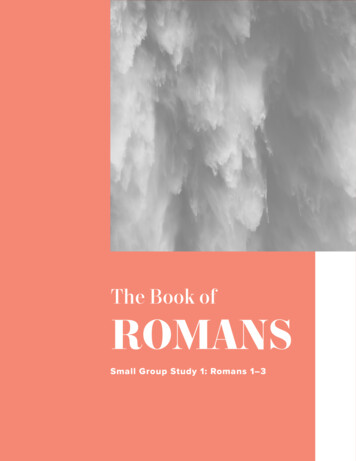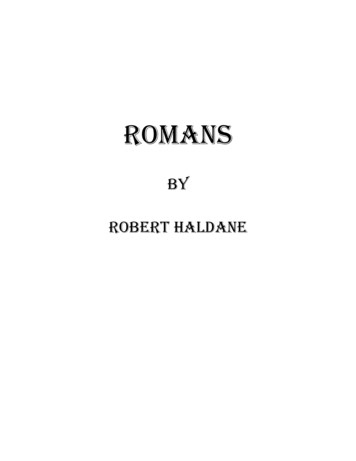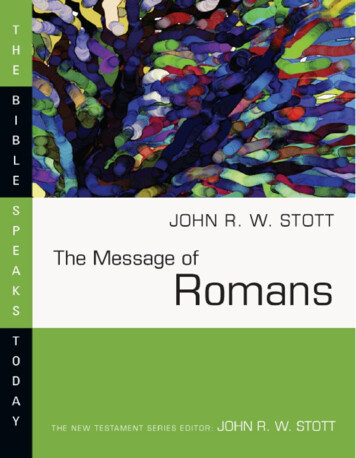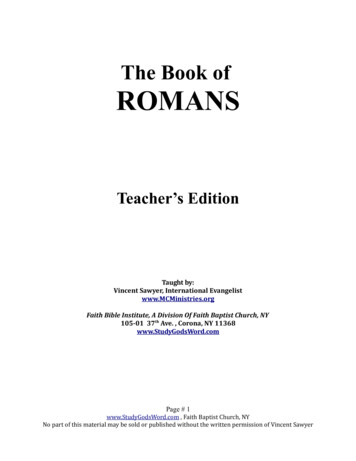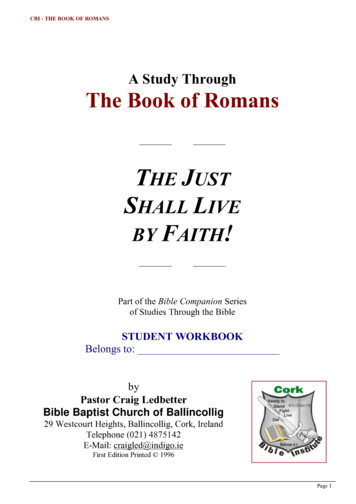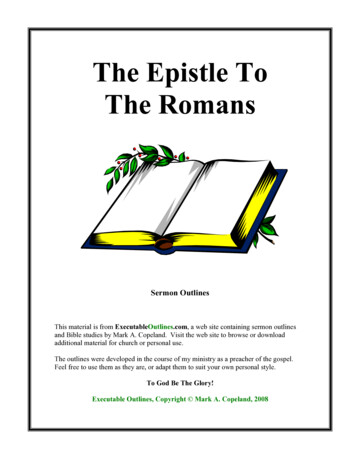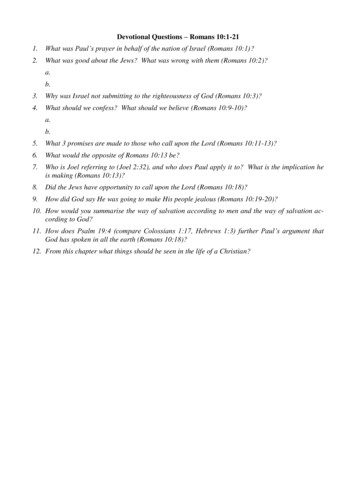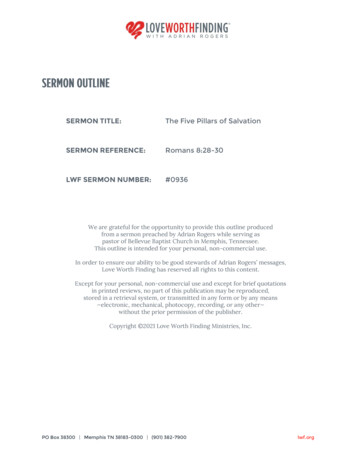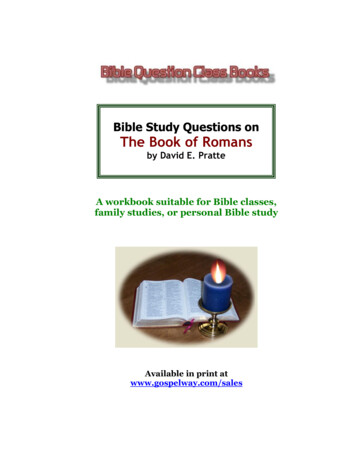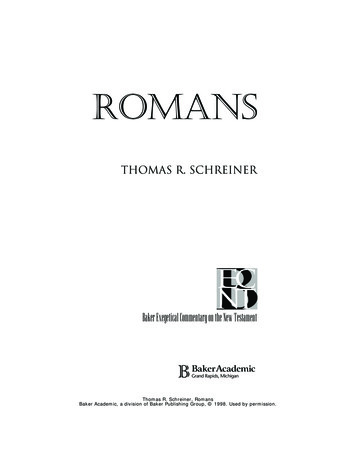
Transcription
00 Schreiner/Romans WT/dk Page iii Friday, September 29, 2006 2:31 PMROMANSTHOMAS R. SCHREINERBaker Exegetical Commentary on the New TestamentkThomas R. Schreiner, RomansBaker Academic, a division of Baker Publishing Group, 1998. Used by permission.
00 Schreiner/Romans WT/dk Page iv Friday, September 29, 2006 2:31 PM 1998 by Thomas R. SchreinerPublished by Baker Academica division of Baker Publishing GroupP.O. Box 6287, Grand Rapids, MI 49516-6287www.bakeracademic.comFifth printing, December 2006Printed in the United States of AmericaAll rights reserved. No part of this publication may be reproduced, stored in a retrieval system, or transmitted in any form or by any means—for example, electronic, photocopy, recording—without the prior written permission of the publisher.The only exception is brief quotations in printed reviews.Library of Congress Cataloging-in-Publication DataSchreiner, Thomas R.Romans / Thomas R. Schreiner.p. cm. — (Baker exegetical commentary on the New Testament ; 6)Includes bibliographical references and index.ISBN 10: 0-8010-2149-9ISBN 978-0-8010-2149-71. Bible. N.T. Romans—Commentaries. I. Title. II. Series.BS2665.3.S36 1998227p.1077—dc2198-18200Thomas R. Schreiner, RomansBaker Academic, a division of Baker Publishing Group, 1998. Used by permission.
00 Schreiner/Romans WT/dk Page v Friday, January 13, 2006 8:58 AMTo John Piper, who has proclaimed to methe supremacy of GodThomas R. Schreiner, RomansBaker Academic, a division of Baker Publishing Group, 1998. Used by permission.
00 Schreiner/Romans WT/dk Page vi Friday, January 13, 2006 8:58 AMThomas R. Schreiner, RomansBaker Academic, a division of Baker Publishing Group, 1998. Used by permission.
00 Schreiner/Romans WT/dk Page vii Friday, January 13, 2006 8:58 AMContentsSeries Preface ixAuthor’s Preface xiiiAbbreviations xvTransliteration xxIntroduction to Romans 1I. The Gospel as the Revelation of God’s Righteousness(1:1–17) 28A. Salutation: The Gospel concerning His Son (1:1–7) 30B. Thanksgiving: Prayer for an Apostolic Visit (1:8–15) 47C. Theme: The Gospel of God’s Righteousness (1:16–17) 58II. God’s Righteousness in His Wrath against Sinners(1:18–3:20) 77A. The Unrighteousness of Gentiles (1:18–32) 81B. The Unrighteousness of Jews (2:1–3:8) 102C. The Unrighteousness of All People (3:9–20) 161III. The Saving Righteousness of God (3:21–4:25) 176A. God’s Righteousness in the Death of Jesus (3:21–26) 178B. Righteousness by Faith for Jews and Gentiles(3:27–31) 200C. Abraham as the Father of Jews and Gentiles (4:1–25) 209IV. Hope as a Result of Righteousness by Faith (5:1–8:39) 245A. Assurance of Hope (5:1–11) 250B. Hope in Christ’s Triumph over Adam’s Sin (5:12–21) 267C. The Triumph of Grace over the Power of Sin (6:1–23) 298D. The Triumph of Grace over the Power of the Law(7:1–8:17) 343E. Assurance of Hope (8:18–39) 430V. God’s Righteousness to Israel and the Gentiles(9:1–11:36) 469A. God’s Saving Promise to Israel (9:1–29) 476B. Israel’s Rejection of God’s Saving Righteousness(9:30–11:10) 531C. God’s Righteousness in His Plan for Jews and Gentiles(11:11–32) 591Thomas R. Schreiner, RomansviiBaker Academic, a division of Baker Publishing Group, 1998. Used by permission.
00 Schreiner/Romans WT/dk Page viii Friday, January 13, 2006 8:58 AMContentsD. Concluding Doxology (11:33–36) 631VI. God’s Righteousness in Everyday Life (12:1–15:13) 639A. Paradigm for Exhortations: Total Dedication to God(12:1–2) 642B. Marks of the Christian Community (12:3–13:14) 649C. A Call for Mutual Acceptance between the Strongand the Weak (14:1–15:13) 703VII. The Extension of God’s Righteousness through the PaulineMission (15:14–16:23) 761A. The Establishment of Churches among the Gentiles(15:14–33) 763B. Coworkers in the Gospel (16:1–23) 785VIII. Final Summary of the Gospel of God’s Righteousness(16:25–27) 810Works Cited 819Index of Subjects 869Index of Authors 873Index of Greek Words 889Index of Scripture and Other Ancient Writingsviii891Thomas R. Schreiner, RomansBaker Academic, a division of Baker Publishing Group, 1998. Used by permission.
00 Schreiner/Romans WT/dk Page ix Friday, January 13, 2006 8:58 AMSeries PrefaceThe chief concern of the Baker Exegetical Commentary on the NewTestament (to be known as BECNT) is to provide, within the framework of informed evangelical thought, commentaries that blendscholarly depth with readability, exegetical detail with sensitivity tothe whole, attention to critical problems with theological awareness. We hope thereby to attract the interest of a fairly wide audience, from the scholar who is looking for a thoughtful and independent examination of the text to the motivated lay Christian whocraves a solid but accessible exposition.Nevertheless, a major purpose is to address the needs of pastorsand others involved in the preaching and exposition of the Scriptures as the uniquely inspired Word of God. This consideration affects directly the parameters of the series. For example, seriousbiblical expositors cannot afford to depend on a superficial treatment that avoids the difficult questions, but neither are they interested in encyclopedic commentaries that seek to cover every conceivable issue that may arise. Our aim, therefore, is to focus onthose problems that have a direct bearing on the meaning of thetext (although selected technical details are treated in the additional notes).Similarly, a special effort is made to avoid treating exegeticalquestions for their own sake, that is, in relative isolation from thethrust of the argument as a whole. This effort may involve (at thediscretion of the individual contributors) abandoning the verse-byverse approach in favor of an exposition that focuses on the paragraph as the main unit of thought. In all cases, however, the commentaries will stress the development of the argument and explicitlyrelate each passage to what precedes and follows it so as to identifyits function in context as clearly as possible.We believe, moreover, that a responsible exegetical commentarymust take fully into account the latest scholarly research, regardless of its source. The attempt to do this in the context of a conservative theological tradition presents certain challenges, and in thepast the results have not always been commendable. In some cases,evangelicals appear to make use of critical scholarship not for thepurpose of genuine interaction but only to dismiss it. In other cases,the interaction glides over into assimilation, theological distincThomas R. Schreiner, RomansixBaker Academic, a division of Baker Publishing Group, 1998. Used by permission.
00 Schreiner/Romans WT/dk Page x Friday, January 13, 2006 8:58 AMSeries Prefacetives are ignored or suppressed, and the end product cannot be differentiated from works that arise from a fundamentally differentstarting point.The contributors to this series attempt to avoid these pitfalls. Onthe one hand, they do not consider traditional opinions to be sacrosanct, and they are certainly committed to do justice to the biblical text whether or not it supports such opinions. On the otherhand, they will not quickly abandon a long-standing view, if thereis persuasive evidence in its favor, for the sake of fashionable theories. What is more important, the contributors share a belief in thetrustworthiness and essential unity of Scripture. They also consider that the historic formulations of Christian doctrine, such asthe ecumenical creeds and many of the documents originating inthe sixteenth-century Reformation, arose from a legitimate readingof Scripture, thus providing a proper framework for its further interpretation. No doubt, the use of such a starting point sometimesresults in the imposition of a foreign construct on the text, but wedeny that it must necessarily do so or that the writers who claim toapproach the text without prejudices are invulnerable to the samedanger.Accordingly, we do not consider theological assumptions—fromwhich, in any case, no commentator is free—to be obstacles to biblical interpretation. On the contrary, an exegete who hopes to understand the apostle Paul in a theological vacuum might just as easily try to interpret Aristotle without regard for the philosophicalframework of his whole work or without having recourse to thosesubsequent philosophical categories that make possible a meaningful contextualization of his thought. It must be emphasized, however, that the contributors to the present series come from a varietyof theological traditions and that they do not all have identicalviews with regard to the proper implementation of these generalprinciples. In the end, all that really matters is whether the seriessucceeds in representing the original text accurately, clearly, andmeaningfully to the contemporary reader.Shading has been used to assist the reader in locating salientsections of the treatment of each passage: the introductory comments and the discussion of structure. Textual variants in theGreek text are signaled in the author’s translation by means of halfbrackets around the relevant word or phrase (e.g., {Gerasenes}),thereby alerting the reader to turn to the additional notes at theend of each exegetical unit for a discussion of the textual problem.The documentation uses the author-date method, in which the basic reference consists of author’s surname year page numxThomas R. Schreiner, RomansBaker Academic, a division of Baker Publishing Group, 1998. Used by permission.
00 Schreiner/Romans WT/dk Page xi Friday, January 13, 2006 8:58 AMSeries Prefaceber(s): Fitzmyer 1981: 297. The only exceptions to this system arewell-known reference works (e.g., BAGD, LSJ, TDNT). Full publication data and a complete set of indexes can be found at the endof the volume.Moisés SilvaThomas R. Schreiner, RomansxiBaker Academic, a division of Baker Publishing Group, 1998. Used by permission.
00 Schreiner/Romans WT/dk Page xii Friday, January 13, 2006 8:58 AMThomas R. Schreiner, RomansBaker Academic, a division of Baker Publishing Group, 1998. Used by permission.
00 Schreiner/Romans WT/dk Page xiii Friday, January 13, 2006 8:58 AMAuthor’s PrefaceWhat is the purpose of another commentary on Romans since anumber of excellent commentaries have been produced? I askedmyself this question when the request to contribute to this seriesarrived. I am in no position to judge whether I have made an original contribution. I have tried to write a scholarly commentary thatfulfills the goals of brevity and lucidity that Calvin praised in commentators. The excessive length of many commentaries today suggests that they are mainly written for other scholars. Two- andthree-volume commentaries are now rather common. I hope scholars profit from my commentary, but I have restricted it to one volume to help laypersons and busy pastors in their exegesis of thetext. At the same time, I hope the commentary is meaty enough toavoid superficiality. One of my goals has been to trace the flow ofthought in the letter so that the reader can understand how the argument unfolds. I have also tried to wrestle with the meaning ofRomans theologically, and this task is not always in vogue today.In particular, I have attempted to demonstrate inductively that theglory of God is the central theme that permeates the letter. All ofPaul’s letters, including Romans, were written to specific situations. Yet his advice was not merely ad hoc. He had a worldviewfrom which he tackled particular situations. We must beware of abstracting his theology so that it floats free of the circumstances thatprecipitated his writings. We must also guard against the tendencyto avoid synthesis in formulating Paul’s thought.I have read representatively from commentaries, monographs,and journal articles on Romans. My intention was not to producethe kind of exhaustive commentary that Cranfield and Dunn havewritten. I am grateful to the many learned and godly scholarswhose exegesis of the epistle deepened my understanding. I am particularly grateful to Ardel Caneday, who carefully read the entiremanuscript, corrected errors, and whose queries caused me to rethink a number of my conclusions. My teaching assistant,Philemon Yong, also checked my bibliography and saved me froma number of errors, for which I am extremely grateful. Randall Tan,also my teaching assistant, deserves a special word of thanks forhelping me proof the entire manuscript under a tight deadline. Ofcourse, I take responsibility for any errors that remain. Thanks areThomas R. Schreiner, RomansxiiiBaker Academic, a division of Baker Publishing Group, 1998. Used by permission.
00 Schreiner/Romans WT/dk Page xiv Friday, January 13, 2006 8:58 AMAuthor’s Prefacealso due to the editor of the Baker Exegetical Commentaries on theNew Testament, Moisés Silva, for inviting me to contribute to theseries, and to Jim Weaver and Wells Turner at Baker Book Housefor their editorial assistance. The joy that predominates in ourhousehold gave me strength when I entered the study, and so I amgrateful to my wife, Diane, and our four children, Daniel, Patrick,John, and Anna. Finally, this book is dedicated to John Piper. As mypastor he has taught me more than anyone about the glory of God,and how stunning it is. Words cannot express what he means to me.Thomas R. SchreinerxivThomas R. Schreiner, RomansBaker Academic, a division of Baker Publishing Group, 1998. Used by permission.
00b Schreiner/Romans WT/dk Page xv Friday, January 13, 2006 9:00 AMAbbreviationsBibliographic and 27NASBNEBNIDNTTNIVNJBNKJVNRSVNTOTOTPThe Anchor Bible Dictionary, edited by D. N. Freedman et al., 6 vols. (New York:Doubleday, 1992)A Greek-English Lexicon of the New Testament and Other Early Christian Literature, by W. Bauer, W. F. Arndt, F. W. Gingrich, and F. W. Danker, 2d ed. (Chicago: University of Chicago Press, 1979)A Greek Grammar of the New Testament and Other Early Christian Literature, byF. Blass, A. Debrunner, and R. W. Funk (Chicago: University of Chicago Press,1961)Dictionary of Paul and His Letters, edited by G. F. Hawthorne and R. P. Martin(Downers Grove, Ill.: InterVarsity, 1993)Exegetical Dictionary of the New Testament , edited by H. Balz and G. Schneider,3 vols. (Grand Rapids: Eerdmans, 1990–93)The Interpreter’s Dictionary of the Bible, supplementary vol., edited by K. Crim etal. (Nashville: Abingdon, 1976)The International Standard Bible Encyclopedia, edited by G. W. Bromiley et al.,4 vols. (Grand Rapids: Eerdmans, 1979–88)King James VersionSeptuagintThe Vocabulary of the Greek Testament: Illustrated from the Papyri and OtherNon-literary Sources, by J. H. Moulton and G. Milligan (repr., Grand Rapids: Eerdmans, 1976)Masoretic TextNovum Testamentum Graece, 25th ed., edited by [E. Nestle], E. Nestle, andK. Aland (Stuttgart: Wirttembergische Bibelanstalt, 1963)Novum Testamentum Graece, 27th rev. ed., edited by [E. and E. Nestle], B. andK. Aland, J. Karavidopoulos, C. M. Martini, and B. M. Metzger (Stuttgart: Deutsche Bibelgesellschaft, 1993)New American Standard BibleNew English BibleThe New International Dictionary of New Testament Theology, edited by L. Coenen, E. Beyreuther, and H. Bietenhard; English translation edited by C. Brown,4 vols. (Grand Rapids: Zondervan, 1975–86)New International VersionNew Jerusalem BibleNew King James VersionNew Revised Standard VersionNew TestamentOld TestamentThe Old Testament Pseudepigrapha, edited by J. H. Charlesworth, 2 vols. (GardenCity, N.Y.: Doubleday, 1983–85)Thomas R. Schreiner, RomansxvBaker Academic, a division of Baker Publishing Group, 1998. Used by permission.
00b Schreiner/Romans WT/dk Page xvi Friday, January 13, 2006 9:00 AMAbbreviationsPLRSVRVTDNTTDOTUBS3UBS4Patrologiae Cursus Completus, Series Latina , edited by J.-P. Migne, 221 vols.(Paris, 1844–55)Revised Standard VersionRevised VersionTheological Dictionary of the New Testament, edited by G. Kittel andG. Friedrich; translated and edited by G. W. Bromiley, 10 vols. (Grand Rapids:Eerdmans, 1964–76)Theological Dictionary of the Old Testament, edited by G. J. Botterweck, H. Ringgren, and H.-J. Fabry; translated by J. T. Willis, G. W. Bromiley, D. E. Green, andD. W. Stott, 8 vols. to date (Grand Rapids: Eerdmans, 1974–)The Greek New Testament, 3d corrected ed., edited by K. Aland, M. Black, C. M.Martini, B. M. Metzger, and A. Wikgren (New York: United Bible Societies,1983)The Greek New Testament, 4th rev. ed., edited by B. Aland, K. Aland,J. Karavidopoulos, C. M. Martini, and B. M. Metzger (New York: United BibleSocieties, 1993)Hebrew BibleGen.Exod.Lev.Num.Deut.Josh.Judg.Ruth1 Sam.2 Sam.1 Kings2 Kings1 uaJudgesRuth1 Samuel2 Samuel1 Kings2 Kings1 Chronicles2 am.Ezek.2 siastesSong of hHaggaiZechariahMalachiEph.Phil.Col.1 Thess.2 Thess.1 Tim.2 Tim.TitusPhilem.EphesiansPhilippiansColossians1 Thessalonians2 Thessalonians1 Timothy2 TimothyTitusPhilemonHeb.James1 Pet.2 Pet.1 John2 John3 JohnJudeRev.HebrewsJames1 Peter2 Peter1 John2 John3 JohnJudeRevelationGreek TestamentMatt.MarkLukeJohnActsRom.1 Cor.2 Cor.Gal.MatthewMarkLukeJohnActsRomans1 Corinthians2 CorinthiansGalatiansOther Jewish and Christian WritingsAdd. Esth.Apoc. Abr.Apoc. Mos.Apoc. Zeph.Bar.2 Bar.xviAdditions to EstherApocalypse of AbrahamApocalypse of MosesApocalypse of ZephaniahBaruch2 (Syriac Apocalypse of)Baruch3 Bar.Barn.BelBib. Ant.1–2 Clem.Did.3 (Greek Apocalypse of)BaruchBarnabasBel and the DragonBiblical Antiquities1–2 ClementDidacheThomas R. Schreiner, RomansBaker Academic, a division of Baker Publishing Group, 1998. Used by permission.
00b Schreiner/Romans WT/dk Page xvii Friday, January 13, 2006 9:00 AMAbbreviationsDiogn.Eccl. Hist.1 Enoch2 Enoch1 Esdr.2 Esdr.Herm. Man.Herm. Sim.Herm. Vis.Ign. Eph.Ign. Magn.Ign. Phld.Ign. Rom.Jdt.Jos. As.Jub.Let. Arist.Let. Jer.1–4 Macc.Mart. Pol.Odes Sol.DiognetusEcclesiastical History1 (Ethiopic) Enoch2 (Slavonic) Enoch1 Esdras2 EsdrasShepherd of Hermas,Mandate(s)Shepherd of Hermas,Similitude(s)Shepherd of Hermas,Vision(s)Ignatius, Letter to theEphesiansIgnatius, Letter to theMagnesiansIgnatius, Letter to thePhiladelphiansIgnatius, Letter to the RomansJudithJoseph and AsenathJubileesLetter of AristeasLetter of Jeremiah1–4 MaccabeesMartyrdom of PolycarpOdes of SolomonPol. Phil.Pr. Azar.Pr. Man.Ps. Sol.Sib. Or.Sir.Sus.T. Abr.T. AsherT. Ben.T. DanT. GadT. Iss.T. JobT. Jos.T. JudahT. LeviT. MosesT. Naph.T. Reub.T. Sim.T. Sol.T. Zeb.Tob.Wis.Polycarp, Letter to thePhilippiansPrayer of AzariahPrayer of ManassehPsalms of SolomonSibylline OraclesSirach (Ecclesiasticus)SusannaTestament of AbrahamTestament of AsherTestament of BenjaminTestament of DanTestament of GadTestament of IssacharTestament of JobTestament of JosephTestament of JudahTestament of LeviTestament of MosesTestament of NaphtaliTestament of ReubenTestament of SimeonTestament of SolomonTestament of ZebulunTobitWisdom of SolomonJosephus and PhiloAbr.Ag. Ap.Alleg. Interp.Anim.Ant.Chang. Nam.Cher.Conf. Tong.Cont. LifeCreat.Decal.DreamsDrunk.Etern. WorldFlacc.FlightGaiusGiantsGood FreeHeirHusb.Hypoth.Jos.On AbrahamAgainst ApionAllegorical InterpretationOn AnimalsJewish AntiquitiesOn the Change of NamesOn the CherubimOn the Confusion ofTonguesOn the Contemplative LifeOn the CreationOn the DecalogueOn DreamsOn DrunkennessOn the Eternity of the WorldFlaccusOn Flight and FindingOn the Embassy to GaiusOn the GiantsEvery Good Man Is FreeWho Is the Heir of DivineThingsOn HusbandryHypothetica/Apology for theJewsOn JosephJ.W.LifeMigr. Abr.The Jewish WarThe Life of JosephusOn the Migration of AbrahamMos.On the Life of MosesPlant.On Noah’s Work as aPlanterPost. CainOn the Posterity and Exile ofCainPrelim. Stud.On the Preliminary StudiesProv.On ProvidenceQuest. Exod.Questions and Answers onExodusQuest. Gen.Questions and Answers onGenesisRewardsOn Rewards and Punishments/On CursesSacr.On the Sacrifices of Abeland CainSobr.On SobrietySpec. LawsOn the Special LawsUnchang.On the Unchangeableness ofGodVirt.On the VirtuesWorse Att. Bet. The Worse Attacks the BetterThomas R. Schreiner, RomansxviiBaker Academic, a division of Baker Publishing Group, 1998. Used by permission.
00b Schreiner/Romans WT/dk Page xviii Friday, January 13, 2006 9:00 AMAbbreviationsRabbinic TractatesThe abbreviations below are used for the names of tractates in the Babylonian Talmud (indicated by a prefixed b.), Palestinian or Jerusalem Talmud ( y.), Mishnah (m.), and Tosepta(t.). The last column gives the numbers of the order and tractate in the Mishnah. Abod. Zar.,Abot Arak.B. Bat.B. Mes.B. Qam.Bek.Ber.Bes.aBik.Dem. Ed. Erub.Git .H ag.H al.Hor.H ul.Kel.Ker.Ketub.Kil.Ma asa.Ma asa. SH.Mak.Maks .Meg.Me il.Menah.Mid.Miqw.Mo ed Qat . Aboda Zara,Abot ArakinBaba, Batra,Baba, Mes.i a,Baba, Qamma,BekorotBerakotBes.aBikkurimDema,i Eduyyot ErubinGit t inH agigaH allaHorayotH ullinKelimKeritotKetubotKil,ayimMa asaerotMa asaer SHeniMakkotMaks irinMegillaMe ilaMenah.otMiddotMiqwa,otMo ed Qat 2.11NazirNed.Neg.Nid.,Ohol. Or.ParaPe,aPesah.Qid.Qin.Ro,s Has .SHab.Sanh.SHeb.SHebu.SHeqal.Sot aSuk.T . YomTa an.TamidTem.Ter.T ohar. Uq.Yad.Yeb.Yoma,Zab.Zebah.NazirNedarimNega imNidda,Oholot OrlaParaPe,aPesah.imQiddus inQinnimRo,s Has s anaSHabbatSanhedrinSHebi itSHebu otSHeqalimSot aSukkaT ebul YomTa anitTamidTemuraTerumotT oharot shim on the biblical books are indicated by the abbreviation Midr. appended in frontof the usual abbreviation for the biblical book (see the above list). The names of other midrashim (e.g., Sipra, Mekilta de Rabbi Ishmael, Pesiqta Rabbati) are spelled in full.TargumimTargumim on the Writings and Prophets are indicated by the abbreviation Tg. appendedin front of the usual abbreviation for the biblical book (see the above list). In the place ofTg., targumim on the Pentateuch use one of the following abbreviations:Frg. Tg.Tg. Neof. 1Tg. Onq.Tg. Ps.-J.Fragmentary TargumTargum Neofiti 1Targum OnqelosTargum Pseudo-JonathanThomas R. Schreiner, RomansBaker Academic, a division of Baker Publishing Group, 1998. Used by permission.xviii
00b Schreiner/Romans WT/dk Page xix Friday, January 13, 2006 9:00 AMAbbreviationsQumran / Dead Sea ScrollsReferences follow the numbering system found in Florentino García Martínez, The DeadSea Scrolls Translated: The Qumran Texts in English, 2d ed., translated by Wilfred G. E.Watson (Leiden: Brill/Grand Rapids: Eerdmans, QSHirSHabba11QMelch11QTempleaCDThanksgiving Hymns/Psalms (Hôdamyôt); reference numbers in parentheses reflect the older, eighteen-column divisionWar Scroll (Milh.ammâ)Commentary (Pesher) on HabakkukManual of Discipline (Serek Hayyah.ad, Rule/Order of the Community)Rule of the Congregation (1Q28a, appendix A to 1QS)Florilegium (4Q174)Halakhic Letter (Miqsamt Ma absaê Tôrâ)Commentary (Pesher) on Genesis (4Q252)Commentary (Pesher) on Psalms (A) (4Q171; formerly 4QpPs37)Songs of the Sabbath Sacrifice (Serek SHîrôt Ôlat Has s abbamt)11Q13 Melchizedek text11Q19 Temple ScrollDamascus DocumentGreek ManuscriptsSigla for Greek manuscripts and other text-critical abbreviations basically follow the pattern in UBS4, pages 4*–52*, and NA27, pages 50*–76*. The original hand of a manuscript isindicated by an asterisk (a*), successive correctors by superscript numbers (a1, a2, etc.).Nonbiblical papyri are abbreviated according to the following list (see BAGD xxxi–xxxii forbibliographic information):P. Fay.P. Lond.P. Oxy.P. Tebt.Papyrus FayûmPapyrus LondonPapyrus OxyrhynchusPapyrus TebtunisThomas R. Schreiner, RomansxixBaker Academic, a division of Baker Publishing Group, 1998. Used by permission.
00b Schreiner/Romans WT/dk Page xx Friday, January 13, 2006 9:00 AMGreek Transliterationaazzllppfphbbhemmmrrcchgg (n)qthnnsßsypsddiixxttwomeekkoouy (u)ÔhNotes on the transliteration of Greek1. Accents, lenis (smooth breathing), and iota subscript are not shown intransliteration.2. The transliteration of asper (rough breathing) precedes a vowel or diphthong (e.g., aJ ha; aiJ hai) and follows r (i.e., rJ rh).3. Gamma is transliterated n only when it precedes g, k, x, or c.4. Upsilon is transliterated u only when it is part of a diphthong (e.g., au, eu,ou, ui).xxThomas R. Schreiner, RomansBaker Academic, a division of Baker Publishing Group, 1998. Used by permission.
00b Schreiner/Romans WT/dk Page xxi Friday, January 13, 2006 9:00 AMHebrew Transliterationabgdhwzjfy klµmˆns[πp xqrcvt,bgdhwzh.t yklmns ps.qrsas s.patah.furtive patah.sebgôls. emrêshort h. îreqlong h. îreq written defectivelyqammes. h. amt ûph. ôlem written fullyh. ôlem written defectivelys ûreqshort qibbûs.long qibbûs. written defectivelyfinal qammes. hem, (Hb; amh)sebgôl yôd (Yb, êy)s. emrê yôd (Ybe êy)h. îreq yôd (Ybi îy)h. am t emp patah.h. am t emp sebgôlh. am t emp qammes.vocal s ebwam,silent s ebwam,tNotes on the transliteration of Hebrew1. Accents are not shown in transliteration.2. Silent s ebwâ, is not indicated in transliteration.3. The unaspirated forms of b g d k p t are not specially indicatedin transliteration.4. Damges forte is indicated by doubling the consonant. Damges present for euphonious reasons is not indicated in transliteration.5. Maqqeµp is represented by a hyphen.Thomas R. Schreiner, RomansxxiBaker Academic, a division of Baker Publishing Group, 1998. Used by permission.
00b Schreiner/Romans WT/dk Page xxii Friday, January 13, 2006 9:00 AMThomas R. Schreiner, RomansBaker Academic, a division of Baker Publishing Group, 1998. Used by permission.
BECNT Schreiner/Romans Page 1 Friday, January 13, 2006 9:22 AMIntroduction to RomansSignificanceThe magisterial character of Romans is apparent to any carefulreader, and its importance is magnified when one reflects on thehistory of exegesis. Even though Augustine never wrote a fulllength commentary on Romans, his theology—which has probablyexerted more influence on the church worldwide than any theologian in the history of the church—was significantly indebted to Romans. The impact of Romans on Martin Luther’s theology is wellknown. He formulated his understanding of sin, law and gospel,faith, salvation, and the righteousness of God by conducting an intensive exegesis of this letter. In his preface to the epistle he says,“This epistle is really the chief part of the New Testament, and istruly the purest gospel. It is worthy not only that every Christianshould know it word for word, by heart, but also that he should occupy himself with it every day, as the daily bread of the soul”(Luther 1972: 365). Luther’s understanding of Romans and Paulinetheology constituted the most significant shift in exegesis and theology since Augustine. Indeed, Luther’s pastoral and theologicalwrestling with the letter continue to influence us to this very day.One should not reflect on the significance of the letter withoutmentioning John Calvin. Calvin’s exegesis of the letter is characterized by the “lucid brevity” (1960: 1) that he considers the chief virtueof the interpreter. Thereby the meaning of the author is not muffledby the verbosity of the commentator. The seriousness with which heapplied himself is evident. “It is, therefore, presumptuous and almost blasphemous to turn the meaning of Scripture around without due care, as though it were some game that we were playing”(1960: 4). He identifies the theme of Romans as follows: “Man’s onlyrighteousness is the mercy of God in Christ, when it is offered by theGospel and received by faith” (1960: 5). He also remarks (1960: 5)that “if we have gained a true understanding of this Epistle, we havean open door to all the most profound treasures of Scripture.”Calvin admirably succeeded in his desire to write a commentarymarked by clarity and brevity, and scholars still read his commentary today as a model of theological and historical exegesis.The impact of Romans lives on in our century. Karl Barth’s 1919commentary on Romans is not consulted for its exegetical mastery,Thomas R. Schreiner, Romans1Baker Academic, a division of Baker Publishing Group, 1998. Used by permission.
BECNT Schreiner/Romans Page 2 Friday, January 13, 2006 9:22 AMIntroduction to Romansbut he jolted his contemporaries awake by listening to the theologyof the apostle Paul. Our first goal as interpreters is to do the same.Exegesis begins with a patient and humble listening to the text,with the willingness to hear an alien word. We are all prone to readour own conceptions into the text. Thus our first task is simply tosee what the text actually says. Those who interpreted the text before us are an immense help in this endeavor, although we mustalso strive to hear the text afresh so that the Word of God will speakto our generation as it did to those who journeyed before us.Authorship and DateNo serious scholar today doubts that Paul wrote Romans. A fewscholars in the history of interpretation, especially at the end of thenineteenth century, have doubted its authenticity. Cranfield (1979:2) remarks rightly that this opinion can be estimated as “among thecuriosities of NT scholarship.” Pauline authorship is one of the assured results of NT scholarship, and thus further discussion on thisissue is unnecessary.What is more interesting is the role that Tertius played as Paul’samanuensis (Rom. 16:22). How much freedom was he given in thecomposition of the le
Romans / Thomas R. Schreiner. p. cm. Ñ (Baker exegetical commentary on the New Testament ; 6) Includes bibliographical references and index. ISBN 10: 0-8010-2149-9 ISBN 978-0-8010-2149-7 1. Bible. N.T. RomansÑCommentaries. I. Title. II. Series. BS2665.3.S36 1998 227 p.1077Ñdc21 98-18200 00 Schreiner/
